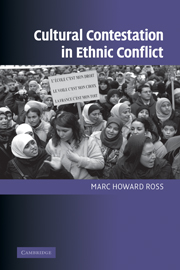Book contents
- Frontmatter
- Contents
- List of figures
- Preface
- 1 Introduction: easy questions and hard answers, what are they fighting about?
- 2 The political psychology of competing narratives
- 3 Narratives and performance: ritual enactment and psychocultural dramas in ethnic conflict
- 4 Loyalist parades in Northern Ireland as recurring psychocultural dramas
- 5 Where is Barcelona? Imagining the nation without a state
- 6 Digging up the past to contest the present: politics and archeology in Jerusalem's Old City
- 7 Dressed to express: Islamic headscarves in French schools
- 8 The politics of memory and memorialization in post-apartheid South Africa
- 9 Enlarging South Africa's symbolic landscape
- 10 Flags, heroes, and statues: inclusive versus exclusive identity markers in the American South
- 11 Culture's central role in ethnic conflict
- References
- Index
- Cambridge Cultural Social Studies
Preface
Published online by Cambridge University Press: 22 September 2009
- Frontmatter
- Contents
- List of figures
- Preface
- 1 Introduction: easy questions and hard answers, what are they fighting about?
- 2 The political psychology of competing narratives
- 3 Narratives and performance: ritual enactment and psychocultural dramas in ethnic conflict
- 4 Loyalist parades in Northern Ireland as recurring psychocultural dramas
- 5 Where is Barcelona? Imagining the nation without a state
- 6 Digging up the past to contest the present: politics and archeology in Jerusalem's Old City
- 7 Dressed to express: Islamic headscarves in French schools
- 8 The politics of memory and memorialization in post-apartheid South Africa
- 9 Enlarging South Africa's symbolic landscape
- 10 Flags, heroes, and statues: inclusive versus exclusive identity markers in the American South
- 11 Culture's central role in ethnic conflict
- References
- Index
- Cambridge Cultural Social Studies
Summary
A decade ago I began puzzling about why, and how, what to some people are innocent cultural expressions are to others provocative, aggressive, politically significant acts. At one level, I had known this was the case for a long time from personal observations and experiences as well as the analyses of scholars such as Murray Edelman and Abner Cohen, both of whom, in different ways, focused my attention on the political uses of culture. My own investigation of culture and politics started thirty years ago when I began a cross-cultural study of conflict that examined differences between high- and low-conflict societies. This project led me to articulate ideas concerning the complementary roles of structural and psychocultural mechanisms that create societal dispositions toward particular forms and levels of conflict and violence. Next I utilized the same framework to explore how any given theory of conflict has crucial implications for the theory and practice of conflict management. For example, if a conflict is viewed as one over resource competition, people trying to end it will seek to negotiate an agreement to divide the resources in a manner that all sides can accept, while those who attribute the same conflict to incompatible identities will make bridging these differences central to their conflict management efforts.
As part of my work on conflict management, I asked why some conflicts are managed more successfully than others, and a case I investigated in depth was the 1989 conflict in France that arose when three Muslim junior high students were expelled for wearing headscarves in school (Ross 1993b).
- Type
- Chapter
- Information
- Cultural Contestation in Ethnic Conflict , pp. xiii - xxPublisher: Cambridge University PressPrint publication year: 2007

